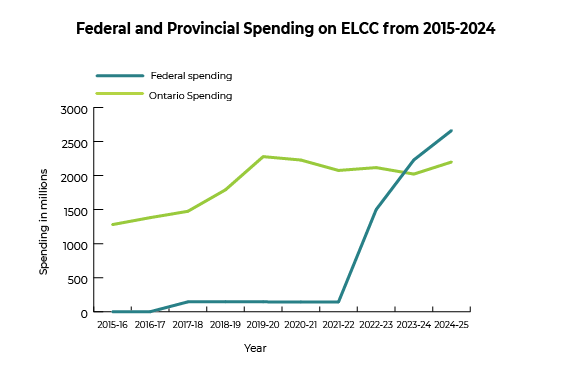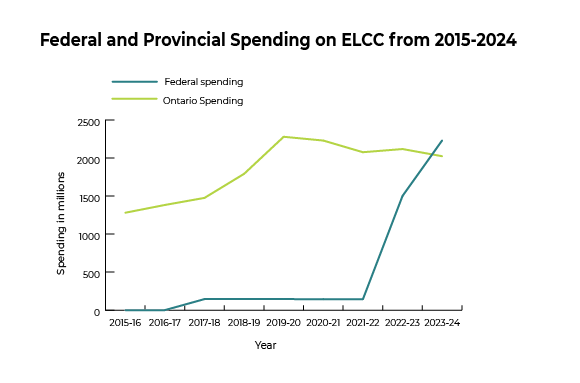In March 2026, the 5-year Canada-Wide Early Learning and Child Care (CWELCC) agreement between Ontario and the federal government is scheduled to end. The agreement brought with it the promise of affordable, high-quality, and accessible child care for children 6 and under. Though many families across the province have certainly gained from reduced child care costs, the path to universal child care has not been without obstacles. With fees reduced to $22 a day, demand for low-cost child care has skyrocketed, and many children on waitlists will age out before they can access care (according to figures extracted from the Ministry of Education Memo from Holly Moran, ADM, to Consolidated Municipal Service Managers (CMSMs) and District Social Services Administration Boards (DSSABs) in March 2025).
Under the Canada-Wide Early Learning and Child Care Agreement (CWELCC), the province committed to creating 86,000 new licensed spaces by 2026, yet, as the Auditor General notes, by December 2024, only 36,287 spaces had been added, leaving 49,713 to reach the target by December 2026. Further, the early learning and child care sector continues to struggle with staff shortages due to inadequate pay and poor working conditions.
The path towards a universal child care system in Ontario has been marked by challenges, particularly in the areas of accessibility and workforce stability. The provincial government was well aware of the scale of the challenge. The Financial Accountability Office of Ontario (FAO) warned in November 2022 that $10-a-day child care would generate demand for an additional 300,000 spaces, far exceeding the 71,000 new spaces Ontario was planning to add under CWELCC by 2026.
Instead of implementing well-known solutions—such as capital grants and loan guarantees for non-profit expansion, public planning mechanisms, and a province-wide wage grid to boost Early Childhood Educator (ECE) compensation—the government failed to provide the necessary support, leading to the current severe capacity and workforce crisis.
For a more detailed breakdown of expenditures, please see the table “Federal And Provincial Contributions To The Cost Of Child Care In Ontario, 2015-16 To 2023-24″.

This approach has created a significant reliance on federal funding to meet the demands of the CWELCC agreement. The federal government has already committed to further funding for CWELCC, promising an additional $16.77 billion to Ontario over the next five years (2026-2031). This federal funding is fundamental, but a strong and stable child care system must be built on the shared commitment from the federal and provincial governments. It is now crucial for the Ontario government to increase its own financial contributions. Without a significant provincial investment, the system will continue to face the same challenges of limited space creation and staff shortages. The current approach is simply not sustainable if Ontario wants to build a truly universal, high-quality, and accessible child care system.

